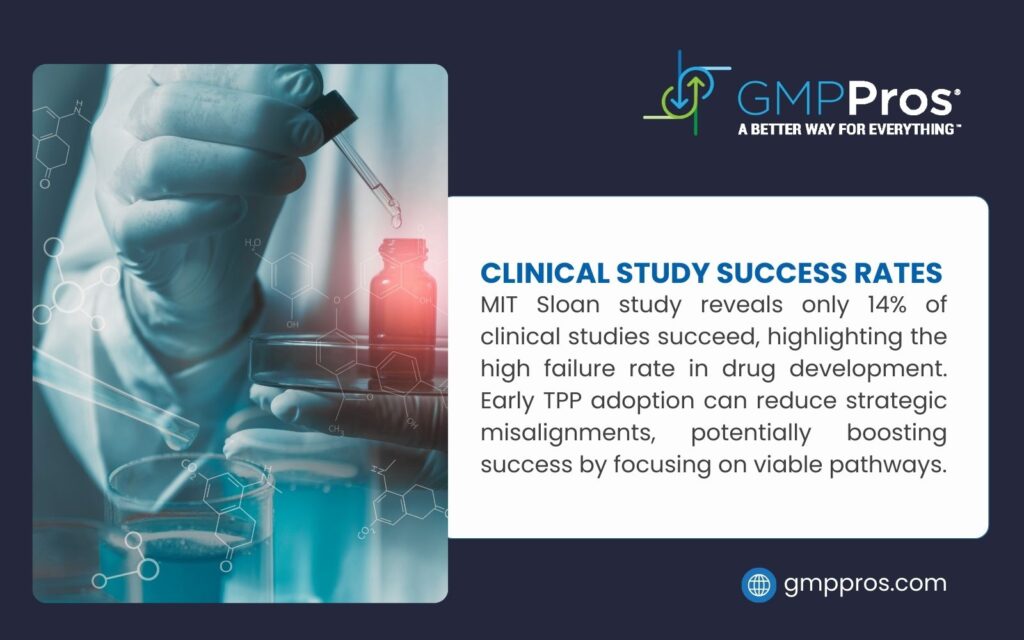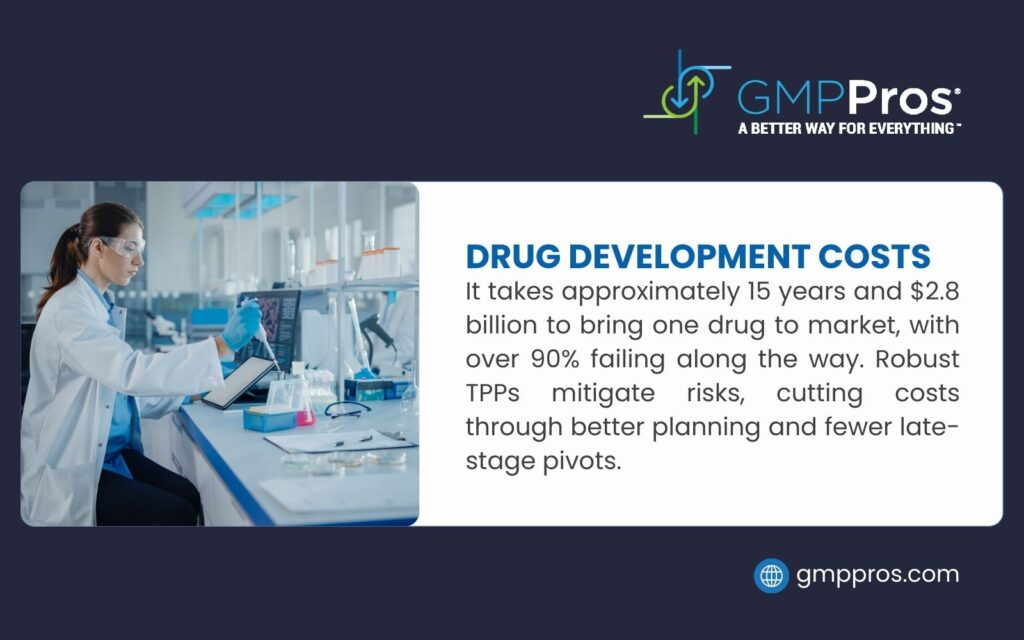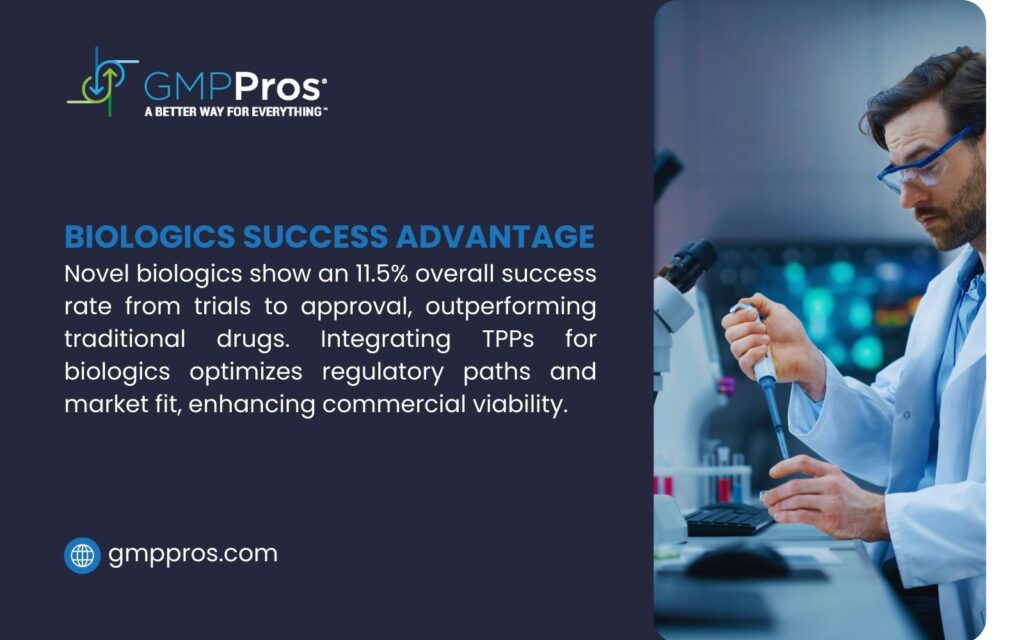A recent study by Premier Research found that 24% of late-stage clinical studies fail due to strategic or commercial reasons, rather than operational issues or product safety. The main cause behind these failures is poor coordination between R&D and commercial functions that could have been prevented with proper target product profile development.
Your target product profile is the main plan that guides the whole drug development process. If companies skip this step, they often face expensive delays, problems with regulators, and poor results in the market. This wastes resources and slows down patient access to new treatments.
What Is a Target Product Profile
A target product profile outlines the desired characteristics and specifications of your pharmaceutical product from early development through commercial launch. This strategic document guides every development decision and regulatory interaction throughout your program.
The regulatory version follows drug labeling sections, while abbreviated versions support commercial communications and business planning. Your TPP defines what success looks like and creates alignment between all stakeholders working on your development program.
TPP Component | Primary Function | Development Impact |
Target Indication | Defines patient population | Affects trial design and endpoints |
Safety Profile | Sets risk tolerance | Influences regulatory pathway |
Efficacy Claims | Specifies clinical benefits | Determines commercial positioning |
Modern pharmaceutical companies treat their target product profile as a living document that evolves with new data and changing market conditions. The electronic batch record often integrates with TPP data to track manufacturing specifications and quality parameters.
Core Elements of Effective Target Product Profiles
Successful target product profiles address three fundamental areas that determine development success. Your TPP must clearly define the clinical value proposition, regulatory strategy, and commercial positioning for your product.
Clinical specifications form the technical foundation of your target product profile. These include dosing regimens, administration routes, patient populations, and safety requirements that guide trial design and regulatory submissions.
| Development Phase | TPP Focus Areas | Key Decisions |
| Preclinical | Target validation, safety profile | Lead compound selection |
| Phase I/II | Dose range, early efficacy signals | Trial design optimization |
| Phase III | Label claims, commercial positioning | Regulatory submission strategy |
Manufacturing specifications within your target product profile connect product quality to commercial success. Your TPP defines critical quality attributes that manufacturing process improvement initiatives must maintain throughout scale-up.
Companies often implement mes implementation during this phase to support data management across multiple regulatory submissions. The commercial framework addresses pricing strategy, market access requirements, and competitive positioning.
Regulatory Strategy Integration
Your target product profile drives regulatory pathway selection and agency interaction strategy. The FDA views TPPs as strategic development tools that help focus discussions and facilitate more productive regulatory meetings.
Companies developing 505b2 drugs often reference competitor TPPs to identify differentiation opportunities and regulatory advantages. This competitive intelligence helps optimize pathway selection and development timelines.
Regulatory Pathway | TPP Requirements | Timeline Benefits |
| Traditional NDA | Complete documentation | Standard 10-12 months review |
| 505b2 Application | Bridging study rationale | 3-7 years vs 8-12 years |
| Fast Track | Unmet medical need proof | 6-18 months saved |
Early FDA engagement using your target product profile can identify potential regulatory issues before they impact critical path activities. Pre-IND meetings and scientific advice sessions provide valuable feedback on TPP assumptions and development plans.
Implementing sap manufacturing execution often supports regulatory TPP requirements by providing consistent data management and quality control across multiple sites and regions.
Clinical Development Planning
Clinical development plans stem directly from your target product profile specifications.
A recent analysis found that only 10%–20% of drug candidates from the beginning of clinical trials to receiving marketing approval succeed, highlighting the importance of strong TPP planning.
Primary endpoint selection represents one of the most critical TPP decisions. Your chosen endpoints must satisfy regulatory requirements while supporting commercial objectives and market access needs.
Clinical Trial Aspect | TPP Influence | Success Factor |
| Primary Endpoints | Regulatory acceptance | Approval probability |
| Patient Population | Recruitment feasibility | Trial timeline |
| Safety Monitoring | Risk management | Regulatory confidence |
Companies working on ind enabling studies use their target product profile to design preclinical programs that directly support clinical development goals. This alignment prevents costly delays and regulatory questions.
Patient population definition affects both regulatory approval and commercial success. Broader populations increase market opportunity but may complicate regulatory approval.

Manufacturing and Quality Considerations
Manufacturing specifications in your target product profile connect product development to commercial production capabilities. Tech transfer pharma programs rely heavily on TPP specifications to maintain product quality across different manufacturing sites and scales.
Process development teams use target product profile requirements to design robust manufacturing processes. Your TPP specifications guide equipment selection, facility design, and quality control strategies.
Quality Parameter | TPP Definition | Manufacturing Impact |
Purity Standards | Active ingredient specs | Process control limits |
Stability Requirements | Shelf life targets | Storage conditions |
Container System | Patient safety needs | Packaging validation |
Companies often implement sap mes implementation to support TPP-driven quality management. These systems provide real-time monitoring of critical quality attributes and automated deviation management.
Good manufacturing practice compliance becomes easier when your target product profile clearly defines quality requirements. Manufacturing teams can design processes that consistently meet TPP specifications.
Market Access and Commercial Strategy
Commercial success depends on how well your target product profile addresses real-world clinical needs and market dynamics.
A study found that nearly two-thirds of recent drug launches failed to meet their first-year sales forecasts.
Payer perspectives become increasingly important in TPP development. Health technology assessment requirements, cost-effectiveness thresholds, and real-world evidence expectations all influence your target product profile specifications.
Commercial Factor | TPP Integration | Market Result |
Clinical Endpoints | Patient outcomes | Physician adoption |
Safety Profile | Risk-benefit balance | Payer acceptance |
Dosing Schedule | Administration ease | Patient compliance |
Market access strategy connects directly to your TPP clinical endpoints and safety profile. Products with endpoints that matter to clinicians and patients achieve better formulary placement and adoption rates.
Life science project management consulting often helps teams balance commercial objectives with regulatory requirements. Professional guidance ensures your TPP supports both approval and commercial success.
Global Development Considerations
International target product profile development requires coordination across multiple regulatory agencies with different requirements. European Medicines Agency requirements often differ from FDA expectations for the same therapeutic area.
ICH guidelines provide harmonization frameworks but don’t eliminate all regional differences. Local requirements for safety data, clinical trial design, and manufacturing specifications still affect your global TPP strategy.
Common technical document preparation relies on well-defined target product profiles to organize data consistently across multiple regulatory submissions. Clear TPP specifications streamline the submission process.
Implementation Best Practices
Successful target product profile implementation requires structured processes, clear governance, and regular updates throughout development. Early stakeholder engagement helps create TPPs that balance diverse requirements and expectations.
Documentation standards ensure your target product profile remains useful throughout development. Version control, change management, and stakeholder communication processes maintain TPP effectiveness over time.
Regular review cycles keep your target product profile current with new data and changing market conditions. Quarterly reviews help identify needed updates before they impact development timelines or commercial positioning.
Biotechnology project management consulting provides specialized expertise for complex TPP implementations. Professional guidance helps teams avoid common pitfalls and implement industry best practices.

Technology Integration and Digital Solutions
Modern target product profile development leverages digital systems and data analytics to improve decision-making. Data quality monitoring systems track TPP-related metrics throughout development.
Cloud-based collaboration platforms help global teams coordinate target product profile activities across multiple sites and time zones. Digital workflows ensure consistent TPP implementation regardless of geographic distribution.
Predictive analytics help teams anticipate potential TPP issues before they impact development timelines. Advanced modeling can identify optimal TPP specifications based on historical data and market dynamics.
Measuring Success and Performance
Target product profile success requires clear metrics and regular performance assessment. Timeline adherence measures how well actual development follows planned milestones defined in your target product profile.
A study found that pharmaceutical research and development returns reached 5.9%, driven by promising late-stage pipeline candidates. Businesses with strong target product profiles capture more of these, improving returns.
Cost management tracks regulatory and development spending against TPP-driven budgets and industry benchmarks. Excessive costs often indicate inefficient processes or poor strategic planning within your TPP framework.
Market performance validates the commercial aspects of your target product profile after launch. Sales data, market share, and physician feedback indicate whether TPP assumptions accurately predicted market needs.

Professional Support and Expertise
GMP Pros specializes in helping pharmaceutical manufacturers develop and execute winning target product profiles that accelerate development timelines while reducing risks and costs. Our embedded consulting approach ensures your team has the expertise needed for successful regulatory outcomes and commercial success.
Contact GMP Pros today to learn how our regulatory strategy experts can help optimize your target product profile development and accelerate your path to market approval.

